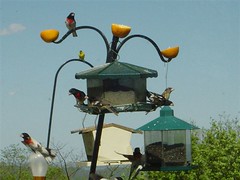Here's the bird list
Click on the link in the title to get web access which will get a properly formatted copy. Blogger has my formatting screwed up.
Lake Leatherwood bird-list
199 species seen, incl 49 with one or two records
Seasons are Spr=Mar-May, Sum=Jun-Aug, Fall=Sep-Nov, Win=Dec-Feb
C common, U uncommon, O occasional, R rare, X single sighting (* breedeer)
note: probability of detection, seen or heard, not rigorous population measures
Sightings of R,X species should be reported to the park office, also any unlisted
W woods, F field, T thicket, M marsh, S shallow & D deep H2O, O flying, B bldg area
Habitat S S F W
__ Common Loon D X
__ Pied-billed Grebe SD U C C
__ Horned Grebe D X
__ American White Pelican X
__ Double-crested Cormorant DO R R
__ Great Blue Heron * SM C U C U
__ Great Egret M O O R
__ Tricolored Heron X
__ Little Blue Heron M O R
__ Snowy Egret X
__ Green Heron M C C X
__ Yellow-crowned Night-Heron MW R X
__ Trumpeter Swan O X
__ Greater White-fronted Goose SM X X
__ Snow Goose O R U
__ Ross's Goose O X
__ Canada Goose * FS C C C C
__ Cackling Goose SMf x
__ Wood Duck * WS C C U
__ American Wigeon DSM X
__ Gadwall SD O U C
__ Green-winged Teal MS O U C
__ Mallard * MS U X C C
__ Northern Pintail S R
__ Blue-winged Teal MS C O
__ Northern Shoveler MS O O R
__ Canvasback DS X
__ Redhead D O R
__ Ring-necked Duck DS U U C
__ Lesser Scaup D O O U
__ Common Goldeneye DS X
__ Bufflehead DS C C C
__ Ruddy Duck D R R R
__ Greater Scaup DS X X
__ Hooded Merganser DS X
__ Red-breasted Merganser DS X
__ Common Merganser DS X X
__ Black Vulture O O O U
__ Turkey Vulture * OW C C C C
__ Osprey DO R
__ Bald Eagle DW O U U
__ Sharp-shinned Hawk W O O U
__ Cooper's Hawk * W O O O O
__ Red-shouldered Hawk * WS C C C C
__ Broad-winged Hawk W U O O
__ Red-tailed Hawk O U U C
__ Golden Eagle O X X X
__ Rough-legged Hawk O X
__ American Kestrel OF X
__ Wild Turkey * WF O O O O
__ Sora M X
__ American Coot SD C C C
__ Killdeer MF C C C O
__ American Woodcock W R O
__ Wilson's Snipe M X
__ Willet SM X
__ Semipalmated Sandpiper SM X
__ Least Sandpiper SM X
__ Pectoral Sandpiper SM X
__ Lesser Yellowlegs M R
__ Solitary Sandpiper M R X
__ Spotted Sandpiper M U X
__ Ring-billed Gull OD X
__ Franklin's Gull OD X
__ Rock Pigeon FB X X
__ Mourning Dove * WF C C U
__ Yellow-billed Cuckoo * W C C R
__ Eastern Screech-Owl * W O O O
__ Great Horned Owl * WF R R
__ Barred Owl * WF R O R
__ Chuck-will's-widow WF X
__ Whip-poor-will WF X
__ Chimney Swift * O C C U
__ Ruby-throated Hummingbird * WB C C
__ Belted Kingfisher * SDW C C U U
__ Red-headed Woodpecker WB X X
__ Red-bellied Woodpecker * W C C C C
__ Yellow-bellied Sapsucker WB U C C
__ Downy Woodpecker * WT C C C C
__ Hairy Woodpecker * W U U U U
__ Northern Flicker W U C C
__ Pileated Woodpecker * W C C C C
__ Olive-sided Flycatcher W X
__ Eastern Wood-Pewee W C C C
__ Yellow-bellied Flycatcher W X
__ Acadian Flycatcher * W U U
__ Willow Flycatcher T O O
__ Least Flycatcher WT O R O
__ Eastern Phoebe * FTM C C C U
__ Great Crested Flycatcher * W C C
__ Eastern Kingbird * WF C C
__ Purple Martin O U U
__ Tree Swallow OM C R
__ Northern Rough-winged Swallow M U R
__ Bank Swallow SM X
__ Cliff Swallow SM O
__ Barn Swallow * MFB C O
__ American Pipit M R R
__ Golden-crowned Kinglet WT O O C
__ Ruby-crowned Kinglet WT U U C
__ Cedar Waxwing WO U X U C
__ Carolina Wren * WT C c c c
__ Bewick's Wren W U U
__ Winter Wren WT U U C
__ House Wren FT U u
__ Sedge Wren MT X X
__ Marsh Wren MT X
__ Gray Catbird * TW U U O X
__ Northern Mockingbird * FB O R O U
__ Brown Thrasher * FTW U R U
__ Eastern Bluebird * WFB C C C C
__ Veery W X
__ Gray-cheeked Thrush W X
__ Swainson's Thrush WT C
__ Hermit Thrush WT O U C
__ Wood Thrush * WT U U U X
__ American Robin * WFB C U C C
__ Blue-gray Gnatcatcher * WT C C U
__ Carolina Chickadee * WTB C C C C
__ Tufted Titmouse * WTB C C C C
__ White-breasted Nuthatch * WB C C C C
__ Brown Creeper
__ Blue Jay * WFB C U C C
__ American Crow * FBO C C C C
__ Fish Crow * FBO C C U
__ European Starling FB U U
__ White-eyed Vireo * WT C C U
__ Bell's Vireo FT X
__ Yellow-throated Vireo * WB U U O
__ Blue-headed Vireo WT O O
__ Warbling Vireo WB O
__ Philadelphia Vireo WT O R R
__ Red-eyed Vireo * WB C C R
__ Purple Finch FB X R U
__ House Finch * WFB U U R R
__ American Goldfinch * WFB C C C C
__ Blue-winged Warbler * WFT C C R
__ Tennessee Warbler FT U
__ Orange-crowned Warbler WT O
__ Nashville Warbler WT U R
__ Northern Parula * W C C R
__ Yellow Warbler WT U R
__ Chestnut-sided Warbler WB O X
__ Magnolia Warbler WT O X
__ Yellow-rumped Warbler FTB U U C
__ Black-throated Green Warbler WT O O
__ Blackburnian Warbler WB X
__ Yellow-throated Warbler WB O U O
__ Pine Warbler * WB U O R R
__ Prairie Warbler * WT U U
__ Palm Warbler FT X
__ Bay-breasted Warbler WB X
__ Blackpoll Warbler WBT X
__ Cerulean Warbler WD X X
__ Black-and-white Warbler * WTB C C R
__ American Redstart WB O
__ Prothonotary Warbler TS R
__ Worm-eating Warbler WT R R
__ Swainson's Warbler * TW X X
__ Ovenbird WT U U R
__ Northern Waterthrush WT U R
__ Louisiana Waterthrush * WT C C R
__ Kentucky Warbler * WT C U
__ Mourning Warbler WT R
__ Common Yellowthroat * ST C U R
__ Hooded Warbler WT X
__ Wilson's Warbler WT U R
__ Canada Warbler WT R
__ Yellow-breasted Chat * T U U R
__ Scarlet Tanager W X X
__ Summer Tanager * WFB U U R
__ Eastern Towhee WT U U U
__ American Tree Sparrow TM R O
__ Chipping Sparrow * TFB C U C
__ Field Sparrow * FTB U U U R
__ Vesper Sparrow FT X
__ Lark Sparrow FT U R
__ Grasshopper Sparrow FT X
__ Savannah Sparrow FT O R R
__ Fox Sparrow WFT U U U
__ Song Sparrow SFT C U C
__ Lincoln's Sparrow ST U U U
__ Swamp Sparrow ST U U U
__ White-crowned Sparrow WFT U U U
__ White-throated Sparrow WTF C C C
__ Dark-eyed Junco WFB C C C
__ Northern Cardinal * FTB C C C C
__ Rose-breasted Grosbeak WB O R
__ Blue Grosbeak F R
__ Lazuli Bunting FW X
__ Indigo Bunting * WFB C C O
__ Red-winged Blackbird * ST C C O R
__ Eastern Meadowlark F X
__ Western Meadowlark F X
__ Common Grackle * WB C C O
__ Great-tailed Grackle FB R
__ Brown-headed Cowbird * WFT C C
__ Baltimore Oriole WFB U R
__ Orchard Oriole * WFB C C
- - - - - - - - - - - - - - - - Commentary - - - - - - - - - - - - -
This table is based on approx 9000 sightings resulting from regular surveys for a five year period. Coverage was best in spring and fall, less so in summer and winter. Breeding status is based on known evidence, some listed birds do breed in the region but I haven't any evidence in the park. The habitat list isn't exhaustive; in particular, the B designation covers the open canopy woodland around the developed part of the park. S for land birds includes the bird blind area. More observers covering some areas more remote from the upper end of the lake could easily pick up more records of the accidentals, and maybe some other species not seen as yet, eg Painted Bunting, Red-breasted Nuthatch. I did very few night hikes, and some time spent then would show many more owls and Whips.
J Pat Valentik 479 981 0901 9/10/2011


